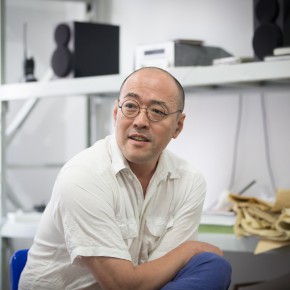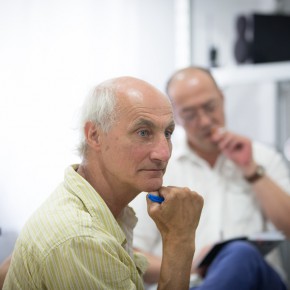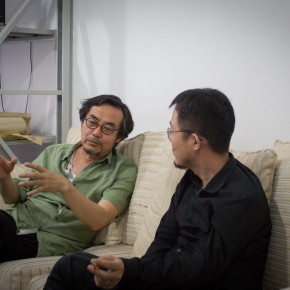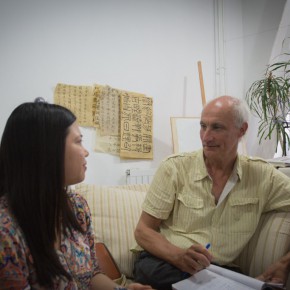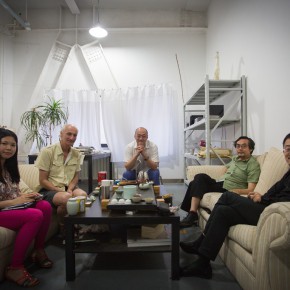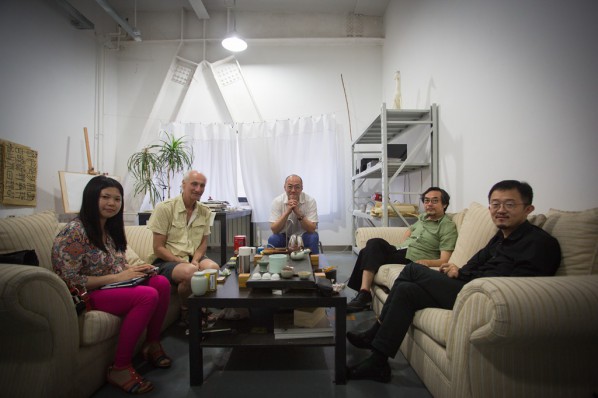
At 5:00 pm on May 30, 2014, at Yu Fan’s office of the Department of Sculpture, CAFA, Dutch artist Henk Visch, together with Professor Sui Jianguo, Associate Professor Yu Fan and young critic Liu Libin had a discussion around figurative sculpture.
Sui Jianguo: I think every sculpture is concrete.
Henk Visch: Concrete means touchable, concrete is the real thing, like material. Concrete is something that you can physically experience. It is a material. Material can have a specific form, sometimes it is a form you can read, you can recognize, as something you know, but it also has a form you don’t know. But as a material it is concrete, it is the real thing that you can experience.
Yu Fan: What is the difference between concrete and figurative?
Henk Visch: Sometimes there are differences but sometimes there are no differences. If you have a figurative sculpture, you can identify it as something you know, but there are many ways of looking at things, there are different understandings of the object. For example, the color red, you can think red is a powerful color, so that it is concrete, it is the power of the color, it is real, and you can also think that the color is like the flag of China, or like the tea in the teapot, the color can bring you to other things, it can remind you, you may have many possible understandings of things. For example, this is a beautiful shape, or it may remind me of the ash or someone who died, so that the color is like a dead thing, a dead body. There are many thoughts about the same object. But for figurative sculptures, you can shape the sculpture, the shape may not come from reality, a figurative sculpture may not be realistic, so it becomes all the information, it doesn’t tell you about the person but tells you about the feeling, so to me a figurative sculpture can be very abstract, so most of the time figurative sculpture comes from reality, it might be drawing, but in my case for example, I can’t make a good drawing, I haven’t been trained in it, so my figurative sculpture doesn’t come from the eyes, from seeing the real things, but comes from the memory, if you have a memory of your body, you can feel your body from inside, so it is not about the realism, it is more about the feeling, so it is about the shape of the reality, it is about feeling, it is more about the nature than about the figurative.
Liu Libin: So is it possible that figurative sculpture is diverted from memory rather than a visual thing?
Henk Visch: Yes. In my work I don’t think about the object. To me the object is a place, if I have a place it has a meaning, changing the place so the meaning changes, if this teapot is here, it is a teapot, if you put your teapot on your head, it is strange, so place changes the meaning of the thing, the place is not material, but material is part of the object, the object has many sources of information, not only the shape, so if you speak about figurative sculpture, you speak about the shape, but just one part of the sculpture, there are many other things, because you have the material, you have the surface, the very important surface, you can see all the detail, maybe you can make a figurative sculpture, like a landscape, or like a motorcycle, or like clouds, or like man, and the figurative is not one layer, one information says it is a boy, but other information says it is land. If you change the chair, you change the meaning, so that place is the first of the sculpture, all sculptures including figurative sculpture are not only figurative but have a lot of information. So I don’t make many figurative sculptures. For example, you are black, black hair, black clothing, you like black drawings, so your figurative sculpture of a man sitting, is not a man sitting, it is black, black is also the information, so many sources of information you have, because black is the information in the memory, your cloth comes from the factory, you have glasses, which are made of glass. We think about the invention of glass, maybe about a big ear, so we think about an animal, maybe the elephant, so many things we can think about. This is a very cheap cloth (pointed to his own cloth), but I wrote down Calvin Klein, now it is very expensive. So you can change the information. Place is very important, if you move things, you change a lot of information. If I put the teapot on the table, there is tea inside, but if I put it on my head, we don’t know if there is tea inside, though it is the same pot, information changed if you change the place, so my artworks are always on an expedition, as an object, they are not so important, because place is important. To me, place (location) is part of the work, so I would see my work in an exhibition with the place. I think sculpture is telling something about the space, and the space of the sculpture is the world, while the space of the painting is in the frames, and it is space and it is a social space, the place we live in. So sculpture develops a social space, which is not so much is about the object. So I do not often use the word of figurative sculpture, because it says nothing about the space, nothing about surface, nothing about material, nothing about color, nothing about detail, the only thing to talk about is the figure.
Sui Jianguo: Carl Andre considered sculpture as the space. What do you think of his idea of minimal?
Henk Visch: They were from the 60s in New York. I think what is important is not the minimal but the space. He took the material from the real world. He put the work in the social, in the outside, in the public place. They were interested in the sculpture of social life. I think it was a social movement in New York that frees the art from being hidden behind a fence. They wanted it to be public, on the street, and to feel free, so they were interested in place, in performance as well.
Sui Jianguo: They wanted to be objective.
Henk Visch: Yes, they wanted to think about what happened, if they used the place, you can create the place like the one, two, three, four, like this, you can change it, he was organizing space, you can walk through, you can count one, two, three, four, you can think about space. Before that everything was in the pet shop, namely the artwork shop, if you made an artwork, the artist made an object, isolated from social life, it was a closed object, and they put them in the beautiful pet shop, so the artwork was not in the social place, because the pet shop hides it from the social life, like a fence, they were excluded from the world, and in the 60s, during the Vietnam war, many artists were angry about it, they said, “life is something else more than killing and bombing.”They were much more aware of real life, so it meant social life, but real life is not a dream life. This is a dream life, you can dream, I like this, I feel good. This is isolation, you go out of the world, and they wanted to go into the world to show their work, they wanted to explore social space, the street, the real thing. Now you are here and then there, if you are in a pet shop, you have no place, you are out of life. I know my students and the students in CAFA, they make an object and put it in the pet shop, and I said object was not the goal, you can says is a beautiful shape, or color, surface, it has many layers of information, if you put it in a pet shop, it is just like a jewelry, beautiful shining, like a luxury good, but it may be from the river, not a luxury good, that is a stone, a super stone, beautiful super stone, so you will forget nature if you put it in the pet shop, so Carl Andre hoped everything in a real life. If you go back for real things and feelings, you find yourself somewhere, and that is called the place.
Liu Libin: We have talked about the concrete, figurative, and realistic, I want to ask Mr. Sui that, why did you create the figurative sculpture themed on the Chinese tunic suit in Australia, did they ask you to do it?
Sui Jianguo: They didn't require me to do it, but I suddenly felt that the Chinese tunic suit was very important.
Liu Libin: You stayed in CAFA for many years, how do you see the realistic tradition of the academy?
Sui Jianguo: Concrete is the characteristic for all the sculptures, it is touchable, it can be felt, it is concrete. I believe all the sculptures are realistic, I think, since the emergence of conceptual art, you can’t see abstract sculpture in the way you previously saw abstract art, once entering the category of abstract art, each abstract sculpture is itself, missing the symbolic meaning, the triangle originally referred to as sharp while round referred to satiation, color red was passion... from then on all the symbolic meanings disappeared from the inside of abstract art, because the symbolic of all abstract arts are poorer than conceptual art, the concept is content. When abstract sculpture showcases itself, realistic sculpture depends on the man behind, but it seems absurd after the emergence of conceptual art. For example, whether it is more correct to make Li Dazhao than Hitler, this abstract element disappeared, leaving the sculpture itself. An ashtray is an ashtray, a teacup is a teacup.
Liu Libin: Your present work “Shape of Time” actually contains your changes in sculpture.
Sui Jianguo: If we talk about conceptual art, we can’t talk about sculpture, so we shall go back to the previous place of sculpture when talking about it. If it represents the integration of figurative and abstract, there isn’t the objective as called by Henk, the objective actually mixes them both. He didn’t want to say his work is objective, but figurative things can be regarded as objective.
Liu Libin: For the retrospective of Has van Dijk held at the UCCA, Ai Weiwei acts like a gangster.
Henk Visch: In Poland, I saw somebody had painted Kama Sutra on the wall, the police said it was forbidden, but on the next street there was a sex shop, and a prostitute. It is a joke, and I think the state is not so serious. You can’t paint but you have a sex shop open?
Hans came from my town, I know him, but he had never told me he had been to China. He had held exhibitions there. I see my friends in the photos of the documentary present at the memorial exhibition. At that time I was busy with many exhibitions but not busy with my friends. In Western media, they think Ai Weiwei was the hero, a brave man, China is stupid. So when I come to China, my friends are surprised. I hate the notion of anti, Ai is not helping.
Journalist: Chen Peihua, edited by Sue/CAFA ART INFO
Photo: Quan Jing/CAFA ART INFO






